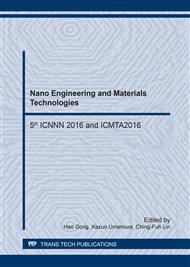p.55
p.59
p.64
p.69
p.74
p.81
p.86
p.91
p.97
Segment Formation in the Work Pieces of ZA22 Grain Refined by Some Rare Earth Elements and Subjected to Equal Channel Angular Pressing, ECAP, Process
Abstract:
Zinc aluminum alloys in general and ZA22 in particular are versatile materials which are widely used in the automobile, aircraft and space craft industries due to their required and attractive properties e.g. high strength-to weight-ratio, good cast ability, high wear and corrosion resistances, in addition to the advantages of low–energy and non-polluting melting. . However, against these attractive properties they have the disadvantage of forming a dendritic structure with large grain size during solidification or homogenization of their casts, which tends to reduce their surface quality, mechanical and impact strengths. Hence it is very essential to modify their structure and refine their grains. In this paper, the effect of the ECAP process on ZA22 alloy after grain refinement of its structure by titanium, titanium plus boron and molybdenum on its metallurgical and mechanical characteristics is investigated. During the investigation, a new phenomenon had occurred on the upper surface of the work pieces, (the surface in contact with the upper part of the ECAP die) similar to the serrated chip type which was first observed by Merchant in1948, This formed the main objective of this paper, in which the causes of this new phenomenon, the mechanism of its formation and how to avoid its occurrence are presented and discussed.
Info:
Periodical:
Pages:
74-78
Citation:
Online since:
March 2017
Authors:
Price:
Сopyright:
© 2017 Trans Tech Publications Ltd. All Rights Reserved
Share:
Citation:


